HC3031 Trimester 1: Case Study of Lululemon and HomeGrocer
VerifiedAdded on 2022/12/15
|7
|2065
|387
Case Study
AI Summary
This case study analyzes two contrasting business scenarios: the success of Lululemon in the athleisure market and the challenges faced by HomeGrocer.com in the online grocery sector. Lululemon's case highlights the importance of understanding market niches, building a strong brand, and creating a loyal customer base through product differentiation and strategic marketing. The analysis covers Lululemon's business model, competitive advantages, and its ability to adapt to changing consumer preferences. Conversely, the HomeGrocer.com case explores the difficulties of entering the online grocery market, including operational challenges, the impact of market fluctuations, and the importance of securing adequate funding. The study examines the company's strategic decisions, including its attempts to adapt to market changes and its ultimate merger with Webvan. The case studies provide valuable insights into global business trends, strategic decision-making, and the factors that contribute to both success and failure in the competitive landscape, using the provided references for context and support.

Trends in global business
Paraphrase This Document
Need a fresh take? Get an instant paraphrase of this document with our AI Paraphraser
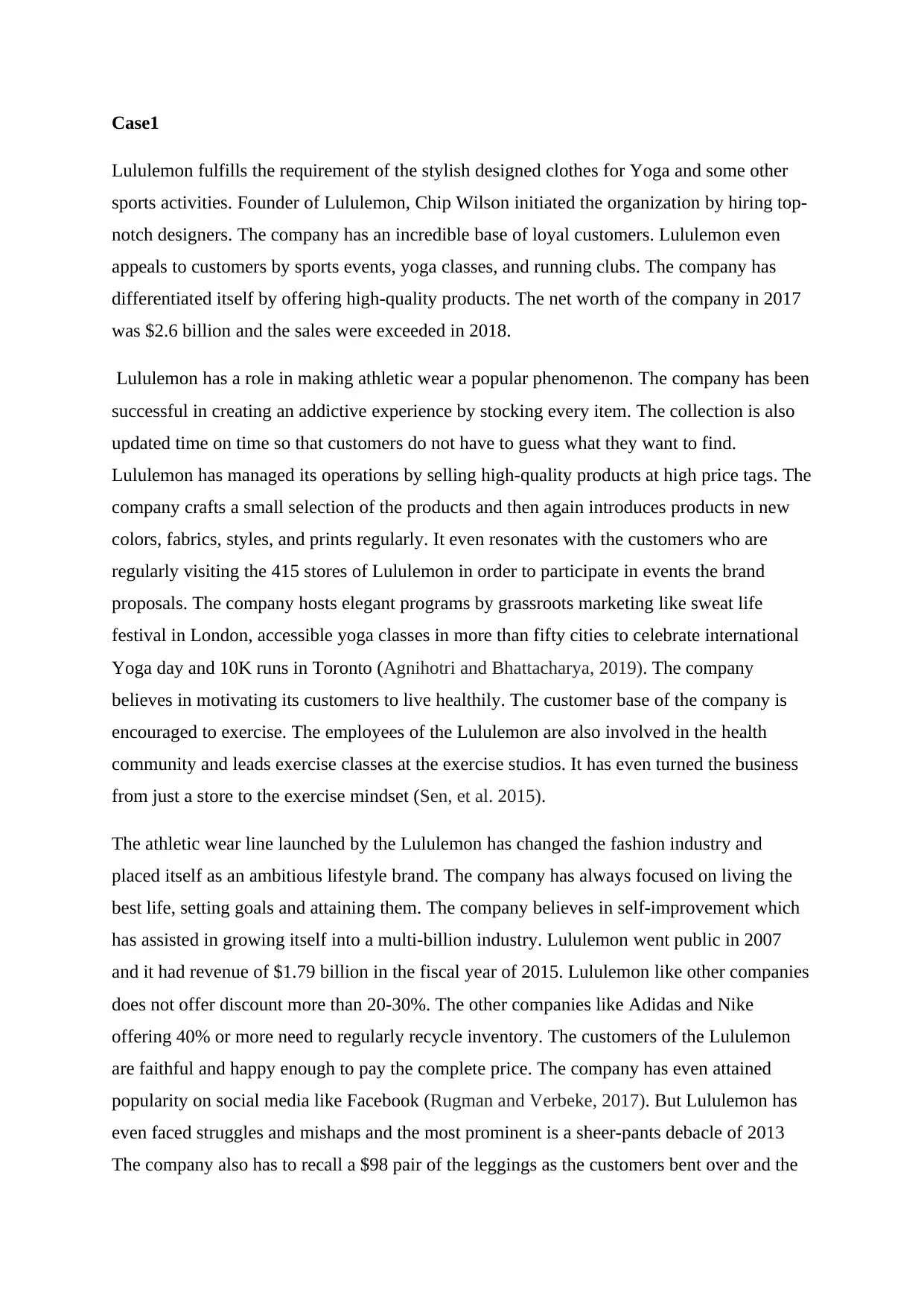
Case1
Lululemon fulfills the requirement of the stylish designed clothes for Yoga and some other
sports activities. Founder of Lululemon, Chip Wilson initiated the organization by hiring top-
notch designers. The company has an incredible base of loyal customers. Lululemon even
appeals to customers by sports events, yoga classes, and running clubs. The company has
differentiated itself by offering high-quality products. The net worth of the company in 2017
was $2.6 billion and the sales were exceeded in 2018.
Lululemon has a role in making athletic wear a popular phenomenon. The company has been
successful in creating an addictive experience by stocking every item. The collection is also
updated time on time so that customers do not have to guess what they want to find.
Lululemon has managed its operations by selling high-quality products at high price tags. The
company crafts a small selection of the products and then again introduces products in new
colors, fabrics, styles, and prints regularly. It even resonates with the customers who are
regularly visiting the 415 stores of Lululemon in order to participate in events the brand
proposals. The company hosts elegant programs by grassroots marketing like sweat life
festival in London, accessible yoga classes in more than fifty cities to celebrate international
Yoga day and 10K runs in Toronto (Agnihotri and Bhattacharya, 2019). The company
believes in motivating its customers to live healthily. The customer base of the company is
encouraged to exercise. The employees of the Lululemon are also involved in the health
community and leads exercise classes at the exercise studios. It has even turned the business
from just a store to the exercise mindset (Sen, et al. 2015).
The athletic wear line launched by the Lululemon has changed the fashion industry and
placed itself as an ambitious lifestyle brand. The company has always focused on living the
best life, setting goals and attaining them. The company believes in self-improvement which
has assisted in growing itself into a multi-billion industry. Lululemon went public in 2007
and it had revenue of $1.79 billion in the fiscal year of 2015. Lululemon like other companies
does not offer discount more than 20-30%. The other companies like Adidas and Nike
offering 40% or more need to regularly recycle inventory. The customers of the Lululemon
are faithful and happy enough to pay the complete price. The company has even attained
popularity on social media like Facebook (Rugman and Verbeke, 2017). But Lululemon has
even faced struggles and mishaps and the most prominent is a sheer-pants debacle of 2013
The company also has to recall a $98 pair of the leggings as the customers bent over and the
Lululemon fulfills the requirement of the stylish designed clothes for Yoga and some other
sports activities. Founder of Lululemon, Chip Wilson initiated the organization by hiring top-
notch designers. The company has an incredible base of loyal customers. Lululemon even
appeals to customers by sports events, yoga classes, and running clubs. The company has
differentiated itself by offering high-quality products. The net worth of the company in 2017
was $2.6 billion and the sales were exceeded in 2018.
Lululemon has a role in making athletic wear a popular phenomenon. The company has been
successful in creating an addictive experience by stocking every item. The collection is also
updated time on time so that customers do not have to guess what they want to find.
Lululemon has managed its operations by selling high-quality products at high price tags. The
company crafts a small selection of the products and then again introduces products in new
colors, fabrics, styles, and prints regularly. It even resonates with the customers who are
regularly visiting the 415 stores of Lululemon in order to participate in events the brand
proposals. The company hosts elegant programs by grassroots marketing like sweat life
festival in London, accessible yoga classes in more than fifty cities to celebrate international
Yoga day and 10K runs in Toronto (Agnihotri and Bhattacharya, 2019). The company
believes in motivating its customers to live healthily. The customer base of the company is
encouraged to exercise. The employees of the Lululemon are also involved in the health
community and leads exercise classes at the exercise studios. It has even turned the business
from just a store to the exercise mindset (Sen, et al. 2015).
The athletic wear line launched by the Lululemon has changed the fashion industry and
placed itself as an ambitious lifestyle brand. The company has always focused on living the
best life, setting goals and attaining them. The company believes in self-improvement which
has assisted in growing itself into a multi-billion industry. Lululemon went public in 2007
and it had revenue of $1.79 billion in the fiscal year of 2015. Lululemon like other companies
does not offer discount more than 20-30%. The other companies like Adidas and Nike
offering 40% or more need to regularly recycle inventory. The customers of the Lululemon
are faithful and happy enough to pay the complete price. The company has even attained
popularity on social media like Facebook (Rugman and Verbeke, 2017). But Lululemon has
even faced struggles and mishaps and the most prominent is a sheer-pants debacle of 2013
The company also has to recall a $98 pair of the leggings as the customers bent over and the
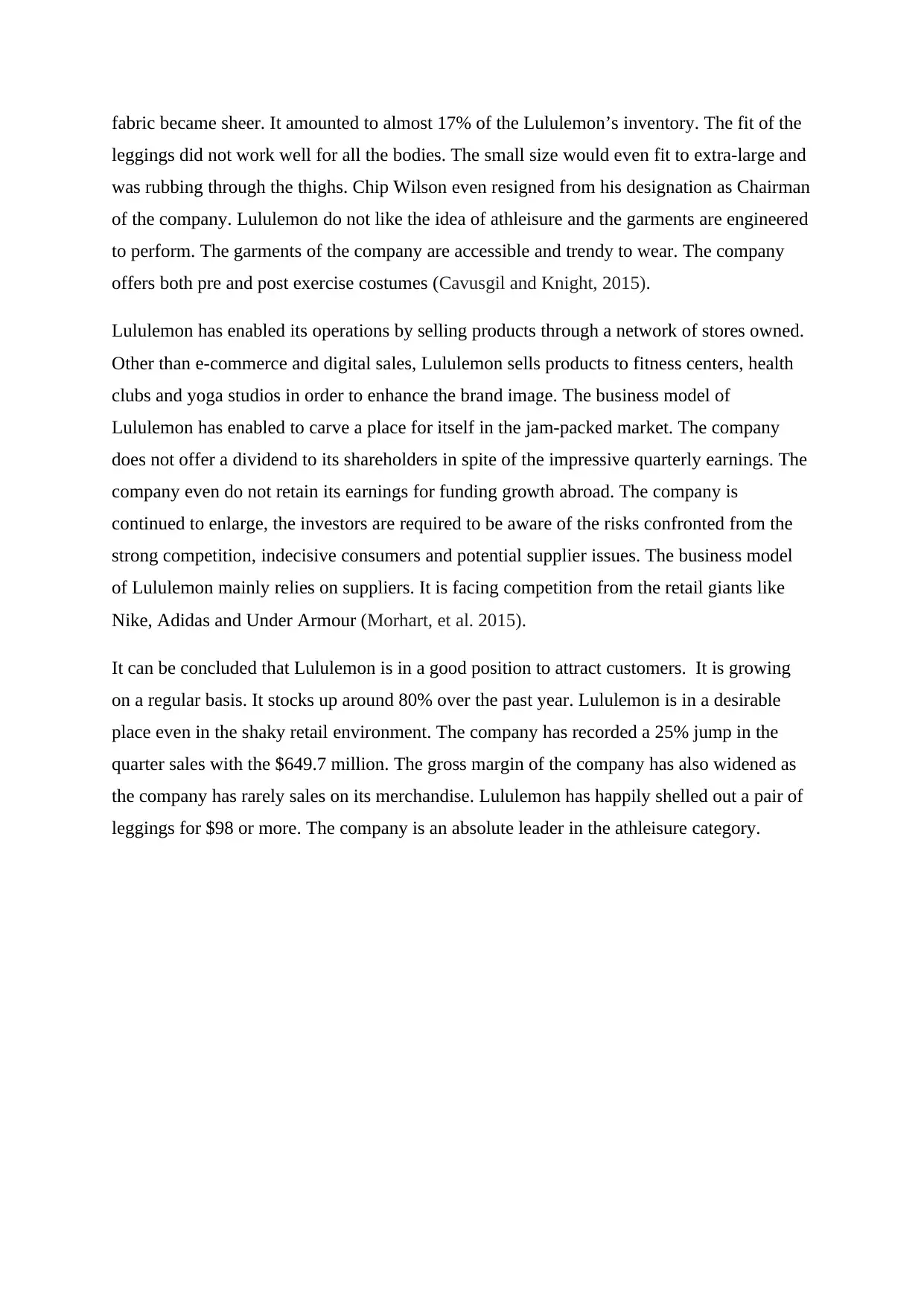
fabric became sheer. It amounted to almost 17% of the Lululemon’s inventory. The fit of the
leggings did not work well for all the bodies. The small size would even fit to extra-large and
was rubbing through the thighs. Chip Wilson even resigned from his designation as Chairman
of the company. Lululemon do not like the idea of athleisure and the garments are engineered
to perform. The garments of the company are accessible and trendy to wear. The company
offers both pre and post exercise costumes (Cavusgil and Knight, 2015).
Lululemon has enabled its operations by selling products through a network of stores owned.
Other than e-commerce and digital sales, Lululemon sells products to fitness centers, health
clubs and yoga studios in order to enhance the brand image. The business model of
Lululemon has enabled to carve a place for itself in the jam-packed market. The company
does not offer a dividend to its shareholders in spite of the impressive quarterly earnings. The
company even do not retain its earnings for funding growth abroad. The company is
continued to enlarge, the investors are required to be aware of the risks confronted from the
strong competition, indecisive consumers and potential supplier issues. The business model
of Lululemon mainly relies on suppliers. It is facing competition from the retail giants like
Nike, Adidas and Under Armour (Morhart, et al. 2015).
It can be concluded that Lululemon is in a good position to attract customers. It is growing
on a regular basis. It stocks up around 80% over the past year. Lululemon is in a desirable
place even in the shaky retail environment. The company has recorded a 25% jump in the
quarter sales with the $649.7 million. The gross margin of the company has also widened as
the company has rarely sales on its merchandise. Lululemon has happily shelled out a pair of
leggings for $98 or more. The company is an absolute leader in the athleisure category.
leggings did not work well for all the bodies. The small size would even fit to extra-large and
was rubbing through the thighs. Chip Wilson even resigned from his designation as Chairman
of the company. Lululemon do not like the idea of athleisure and the garments are engineered
to perform. The garments of the company are accessible and trendy to wear. The company
offers both pre and post exercise costumes (Cavusgil and Knight, 2015).
Lululemon has enabled its operations by selling products through a network of stores owned.
Other than e-commerce and digital sales, Lululemon sells products to fitness centers, health
clubs and yoga studios in order to enhance the brand image. The business model of
Lululemon has enabled to carve a place for itself in the jam-packed market. The company
does not offer a dividend to its shareholders in spite of the impressive quarterly earnings. The
company even do not retain its earnings for funding growth abroad. The company is
continued to enlarge, the investors are required to be aware of the risks confronted from the
strong competition, indecisive consumers and potential supplier issues. The business model
of Lululemon mainly relies on suppliers. It is facing competition from the retail giants like
Nike, Adidas and Under Armour (Morhart, et al. 2015).
It can be concluded that Lululemon is in a good position to attract customers. It is growing
on a regular basis. It stocks up around 80% over the past year. Lululemon is in a desirable
place even in the shaky retail environment. The company has recorded a 25% jump in the
quarter sales with the $649.7 million. The gross margin of the company has also widened as
the company has rarely sales on its merchandise. Lululemon has happily shelled out a pair of
leggings for $98 or more. The company is an absolute leader in the athleisure category.
⊘ This is a preview!⊘
Do you want full access?
Subscribe today to unlock all pages.

Trusted by 1+ million students worldwide
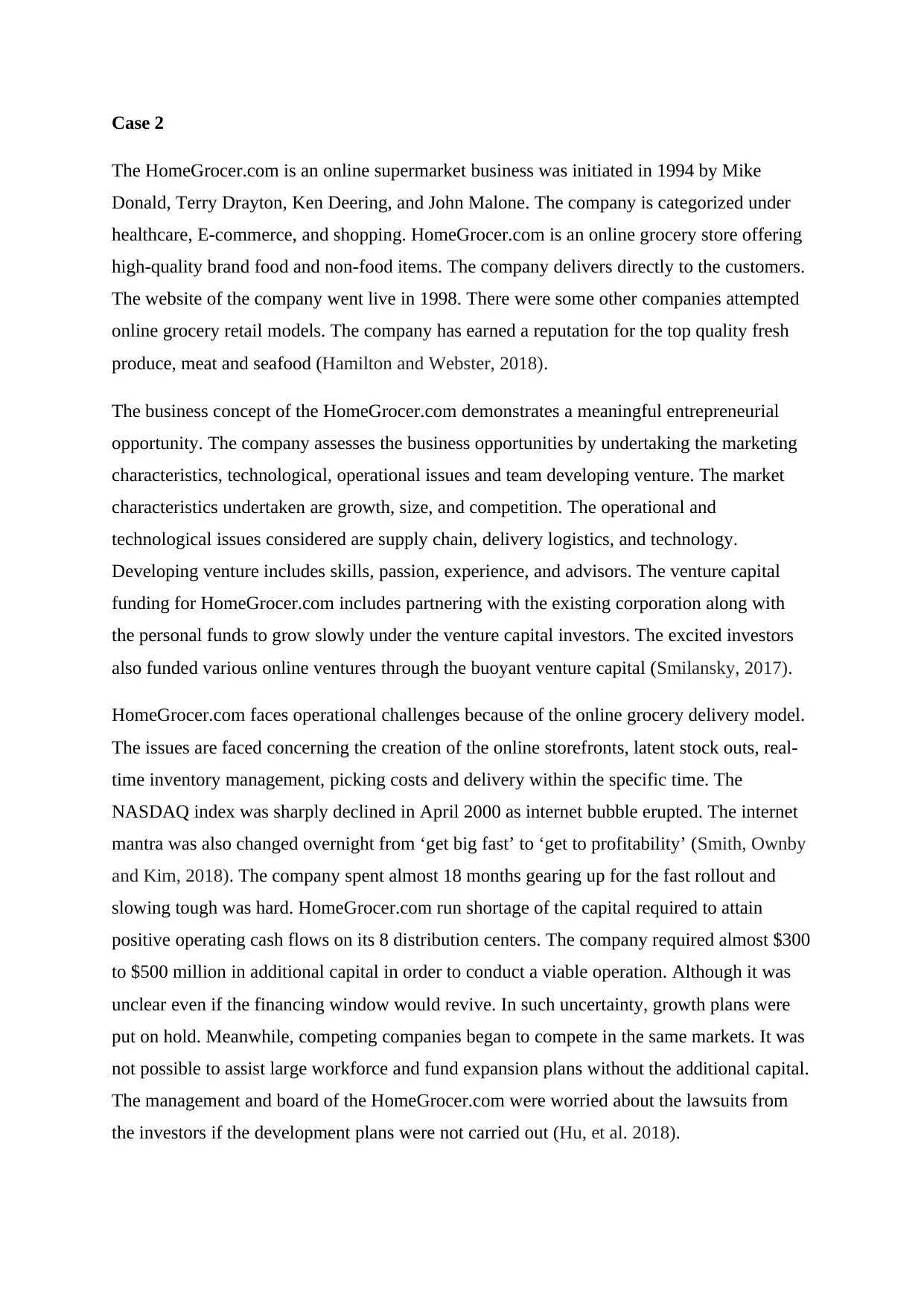
Case 2
The HomeGrocer.com is an online supermarket business was initiated in 1994 by Mike
Donald, Terry Drayton, Ken Deering, and John Malone. The company is categorized under
healthcare, E-commerce, and shopping. HomeGrocer.com is an online grocery store offering
high-quality brand food and non-food items. The company delivers directly to the customers.
The website of the company went live in 1998. There were some other companies attempted
online grocery retail models. The company has earned a reputation for the top quality fresh
produce, meat and seafood (Hamilton and Webster, 2018).
The business concept of the HomeGrocer.com demonstrates a meaningful entrepreneurial
opportunity. The company assesses the business opportunities by undertaking the marketing
characteristics, technological, operational issues and team developing venture. The market
characteristics undertaken are growth, size, and competition. The operational and
technological issues considered are supply chain, delivery logistics, and technology.
Developing venture includes skills, passion, experience, and advisors. The venture capital
funding for HomeGrocer.com includes partnering with the existing corporation along with
the personal funds to grow slowly under the venture capital investors. The excited investors
also funded various online ventures through the buoyant venture capital (Smilansky, 2017).
HomeGrocer.com faces operational challenges because of the online grocery delivery model.
The issues are faced concerning the creation of the online storefronts, latent stock outs, real-
time inventory management, picking costs and delivery within the specific time. The
NASDAQ index was sharply declined in April 2000 as internet bubble erupted. The internet
mantra was also changed overnight from ‘get big fast’ to ‘get to profitability’ (Smith, Ownby
and Kim, 2018). The company spent almost 18 months gearing up for the fast rollout and
slowing tough was hard. HomeGrocer.com run shortage of the capital required to attain
positive operating cash flows on its 8 distribution centers. The company required almost $300
to $500 million in additional capital in order to conduct a viable operation. Although it was
unclear even if the financing window would revive. In such uncertainty, growth plans were
put on hold. Meanwhile, competing companies began to compete in the same markets. It was
not possible to assist large workforce and fund expansion plans without the additional capital.
The management and board of the HomeGrocer.com were worried about the lawsuits from
the investors if the development plans were not carried out (Hu, et al. 2018).
The HomeGrocer.com is an online supermarket business was initiated in 1994 by Mike
Donald, Terry Drayton, Ken Deering, and John Malone. The company is categorized under
healthcare, E-commerce, and shopping. HomeGrocer.com is an online grocery store offering
high-quality brand food and non-food items. The company delivers directly to the customers.
The website of the company went live in 1998. There were some other companies attempted
online grocery retail models. The company has earned a reputation for the top quality fresh
produce, meat and seafood (Hamilton and Webster, 2018).
The business concept of the HomeGrocer.com demonstrates a meaningful entrepreneurial
opportunity. The company assesses the business opportunities by undertaking the marketing
characteristics, technological, operational issues and team developing venture. The market
characteristics undertaken are growth, size, and competition. The operational and
technological issues considered are supply chain, delivery logistics, and technology.
Developing venture includes skills, passion, experience, and advisors. The venture capital
funding for HomeGrocer.com includes partnering with the existing corporation along with
the personal funds to grow slowly under the venture capital investors. The excited investors
also funded various online ventures through the buoyant venture capital (Smilansky, 2017).
HomeGrocer.com faces operational challenges because of the online grocery delivery model.
The issues are faced concerning the creation of the online storefronts, latent stock outs, real-
time inventory management, picking costs and delivery within the specific time. The
NASDAQ index was sharply declined in April 2000 as internet bubble erupted. The internet
mantra was also changed overnight from ‘get big fast’ to ‘get to profitability’ (Smith, Ownby
and Kim, 2018). The company spent almost 18 months gearing up for the fast rollout and
slowing tough was hard. HomeGrocer.com run shortage of the capital required to attain
positive operating cash flows on its 8 distribution centers. The company required almost $300
to $500 million in additional capital in order to conduct a viable operation. Although it was
unclear even if the financing window would revive. In such uncertainty, growth plans were
put on hold. Meanwhile, competing companies began to compete in the same markets. It was
not possible to assist large workforce and fund expansion plans without the additional capital.
The management and board of the HomeGrocer.com were worried about the lawsuits from
the investors if the development plans were not carried out (Hu, et al. 2018).
Paraphrase This Document
Need a fresh take? Get an instant paraphrase of this document with our AI Paraphraser
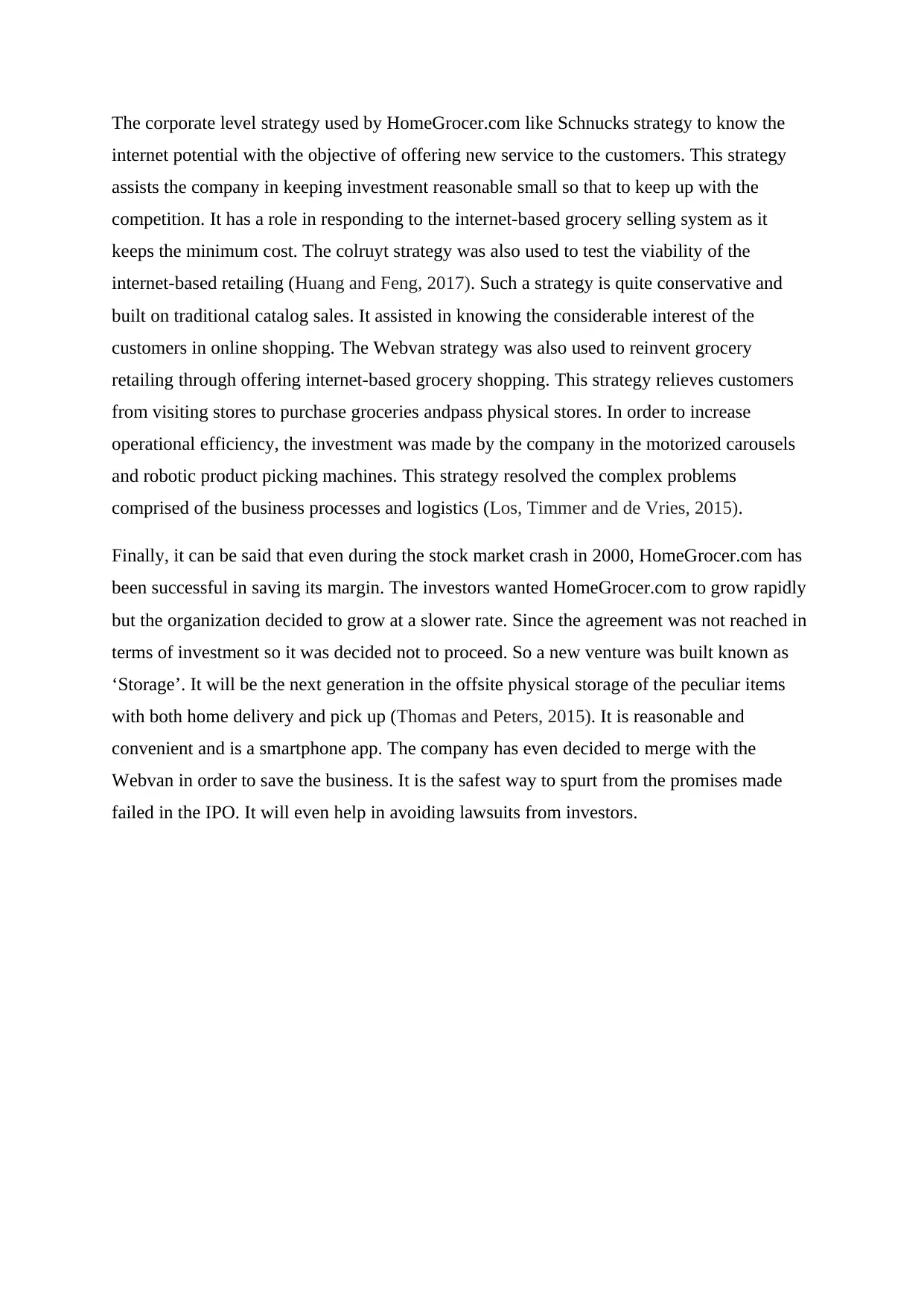
The corporate level strategy used by HomeGrocer.com like Schnucks strategy to know the
internet potential with the objective of offering new service to the customers. This strategy
assists the company in keeping investment reasonable small so that to keep up with the
competition. It has a role in responding to the internet-based grocery selling system as it
keeps the minimum cost. The colruyt strategy was also used to test the viability of the
internet-based retailing (Huang and Feng, 2017). Such a strategy is quite conservative and
built on traditional catalog sales. It assisted in knowing the considerable interest of the
customers in online shopping. The Webvan strategy was also used to reinvent grocery
retailing through offering internet-based grocery shopping. This strategy relieves customers
from visiting stores to purchase groceries andpass physical stores. In order to increase
operational efficiency, the investment was made by the company in the motorized carousels
and robotic product picking machines. This strategy resolved the complex problems
comprised of the business processes and logistics (Los, Timmer and de Vries, 2015).
Finally, it can be said that even during the stock market crash in 2000, HomeGrocer.com has
been successful in saving its margin. The investors wanted HomeGrocer.com to grow rapidly
but the organization decided to grow at a slower rate. Since the agreement was not reached in
terms of investment so it was decided not to proceed. So a new venture was built known as
‘Storage’. It will be the next generation in the offsite physical storage of the peculiar items
with both home delivery and pick up (Thomas and Peters, 2015). It is reasonable and
convenient and is a smartphone app. The company has even decided to merge with the
Webvan in order to save the business. It is the safest way to spurt from the promises made
failed in the IPO. It will even help in avoiding lawsuits from investors.
internet potential with the objective of offering new service to the customers. This strategy
assists the company in keeping investment reasonable small so that to keep up with the
competition. It has a role in responding to the internet-based grocery selling system as it
keeps the minimum cost. The colruyt strategy was also used to test the viability of the
internet-based retailing (Huang and Feng, 2017). Such a strategy is quite conservative and
built on traditional catalog sales. It assisted in knowing the considerable interest of the
customers in online shopping. The Webvan strategy was also used to reinvent grocery
retailing through offering internet-based grocery shopping. This strategy relieves customers
from visiting stores to purchase groceries andpass physical stores. In order to increase
operational efficiency, the investment was made by the company in the motorized carousels
and robotic product picking machines. This strategy resolved the complex problems
comprised of the business processes and logistics (Los, Timmer and de Vries, 2015).
Finally, it can be said that even during the stock market crash in 2000, HomeGrocer.com has
been successful in saving its margin. The investors wanted HomeGrocer.com to grow rapidly
but the organization decided to grow at a slower rate. Since the agreement was not reached in
terms of investment so it was decided not to proceed. So a new venture was built known as
‘Storage’. It will be the next generation in the offsite physical storage of the peculiar items
with both home delivery and pick up (Thomas and Peters, 2015). It is reasonable and
convenient and is a smartphone app. The company has even decided to merge with the
Webvan in order to save the business. It is the safest way to spurt from the promises made
failed in the IPO. It will even help in avoiding lawsuits from investors.
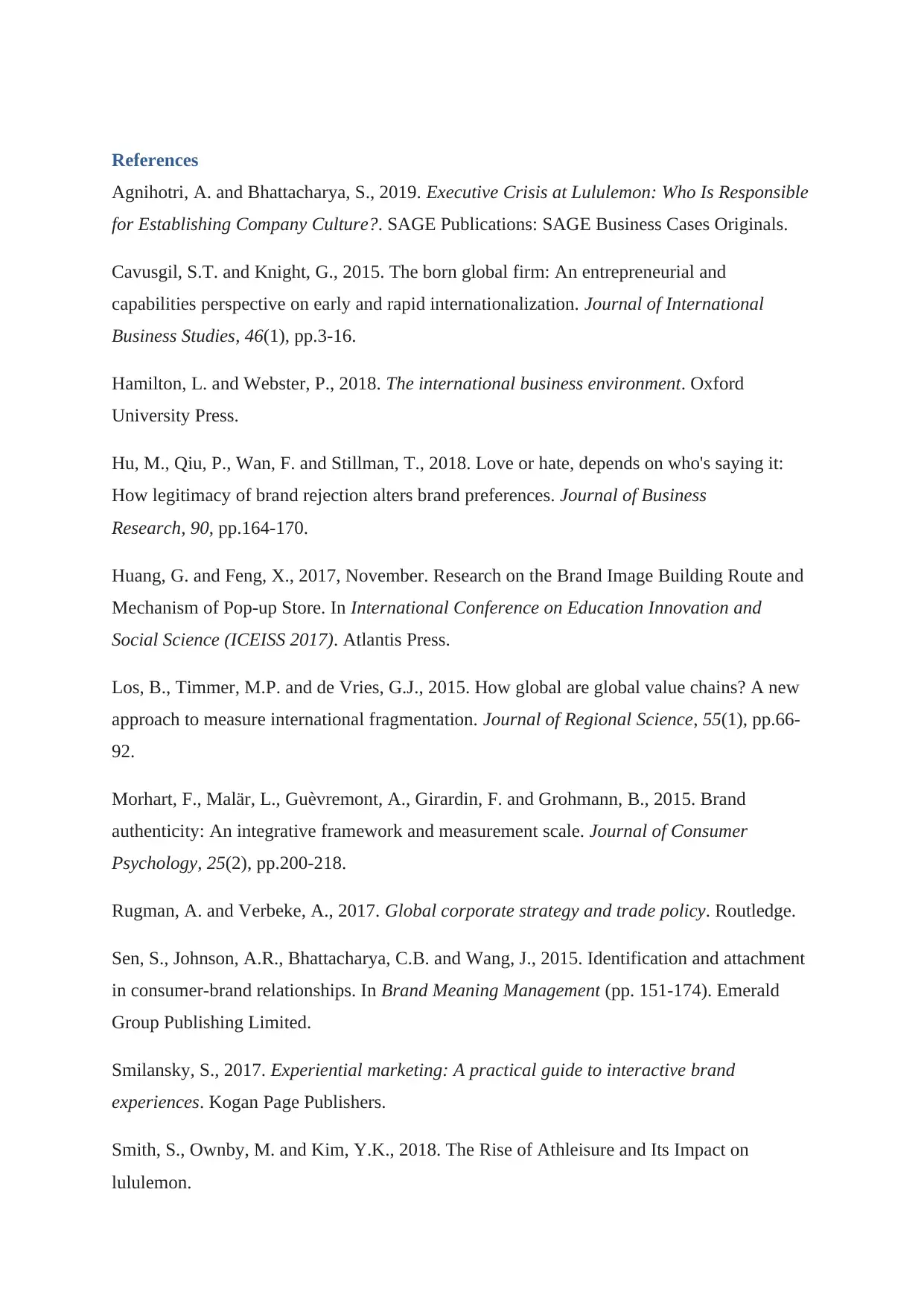
References
Agnihotri, A. and Bhattacharya, S., 2019. Executive Crisis at Lululemon: Who Is Responsible
for Establishing Company Culture?. SAGE Publications: SAGE Business Cases Originals.
Cavusgil, S.T. and Knight, G., 2015. The born global firm: An entrepreneurial and
capabilities perspective on early and rapid internationalization. Journal of International
Business Studies, 46(1), pp.3-16.
Hamilton, L. and Webster, P., 2018. The international business environment. Oxford
University Press.
Hu, M., Qiu, P., Wan, F. and Stillman, T., 2018. Love or hate, depends on who's saying it:
How legitimacy of brand rejection alters brand preferences. Journal of Business
Research, 90, pp.164-170.
Huang, G. and Feng, X., 2017, November. Research on the Brand Image Building Route and
Mechanism of Pop-up Store. In International Conference on Education Innovation and
Social Science (ICEISS 2017). Atlantis Press.
Los, B., Timmer, M.P. and de Vries, G.J., 2015. How global are global value chains? A new
approach to measure international fragmentation. Journal of Regional Science, 55(1), pp.66-
92.
Morhart, F., Malär, L., Guèvremont, A., Girardin, F. and Grohmann, B., 2015. Brand
authenticity: An integrative framework and measurement scale. Journal of Consumer
Psychology, 25(2), pp.200-218.
Rugman, A. and Verbeke, A., 2017. Global corporate strategy and trade policy. Routledge.
Sen, S., Johnson, A.R., Bhattacharya, C.B. and Wang, J., 2015. Identification and attachment
in consumer-brand relationships. In Brand Meaning Management (pp. 151-174). Emerald
Group Publishing Limited.
Smilansky, S., 2017. Experiential marketing: A practical guide to interactive brand
experiences. Kogan Page Publishers.
Smith, S., Ownby, M. and Kim, Y.K., 2018. The Rise of Athleisure and Its Impact on
lululemon.
Agnihotri, A. and Bhattacharya, S., 2019. Executive Crisis at Lululemon: Who Is Responsible
for Establishing Company Culture?. SAGE Publications: SAGE Business Cases Originals.
Cavusgil, S.T. and Knight, G., 2015. The born global firm: An entrepreneurial and
capabilities perspective on early and rapid internationalization. Journal of International
Business Studies, 46(1), pp.3-16.
Hamilton, L. and Webster, P., 2018. The international business environment. Oxford
University Press.
Hu, M., Qiu, P., Wan, F. and Stillman, T., 2018. Love or hate, depends on who's saying it:
How legitimacy of brand rejection alters brand preferences. Journal of Business
Research, 90, pp.164-170.
Huang, G. and Feng, X., 2017, November. Research on the Brand Image Building Route and
Mechanism of Pop-up Store. In International Conference on Education Innovation and
Social Science (ICEISS 2017). Atlantis Press.
Los, B., Timmer, M.P. and de Vries, G.J., 2015. How global are global value chains? A new
approach to measure international fragmentation. Journal of Regional Science, 55(1), pp.66-
92.
Morhart, F., Malär, L., Guèvremont, A., Girardin, F. and Grohmann, B., 2015. Brand
authenticity: An integrative framework and measurement scale. Journal of Consumer
Psychology, 25(2), pp.200-218.
Rugman, A. and Verbeke, A., 2017. Global corporate strategy and trade policy. Routledge.
Sen, S., Johnson, A.R., Bhattacharya, C.B. and Wang, J., 2015. Identification and attachment
in consumer-brand relationships. In Brand Meaning Management (pp. 151-174). Emerald
Group Publishing Limited.
Smilansky, S., 2017. Experiential marketing: A practical guide to interactive brand
experiences. Kogan Page Publishers.
Smith, S., Ownby, M. and Kim, Y.K., 2018. The Rise of Athleisure and Its Impact on
lululemon.
⊘ This is a preview!⊘
Do you want full access?
Subscribe today to unlock all pages.

Trusted by 1+ million students worldwide
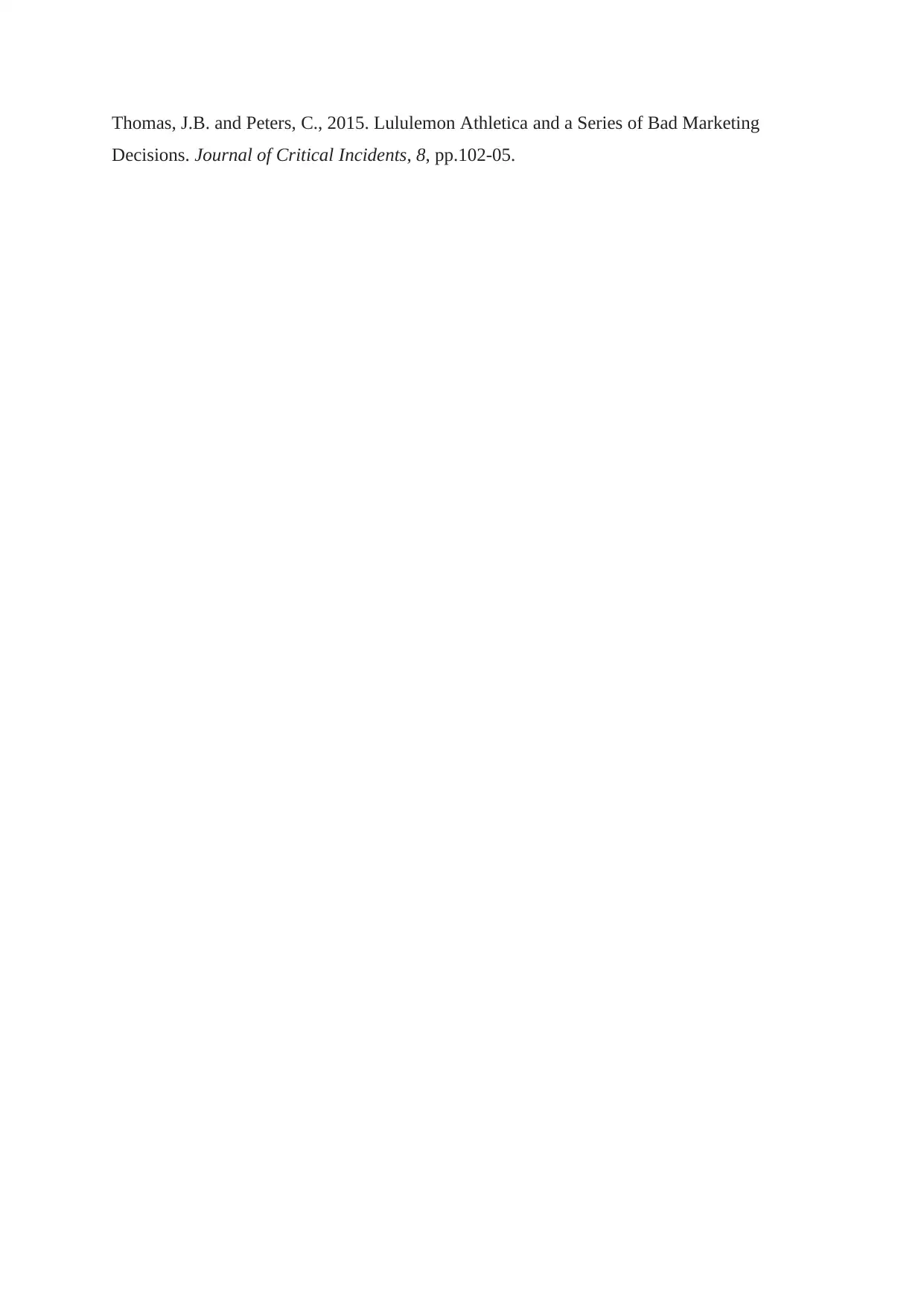
Thomas, J.B. and Peters, C., 2015. Lululemon Athletica and a Series of Bad Marketing
Decisions. Journal of Critical Incidents, 8, pp.102-05.
Decisions. Journal of Critical Incidents, 8, pp.102-05.
1 out of 7
Related Documents
Your All-in-One AI-Powered Toolkit for Academic Success.
+13062052269
info@desklib.com
Available 24*7 on WhatsApp / Email
![[object Object]](/_next/static/media/star-bottom.7253800d.svg)
Unlock your academic potential
Copyright © 2020–2025 A2Z Services. All Rights Reserved. Developed and managed by ZUCOL.





